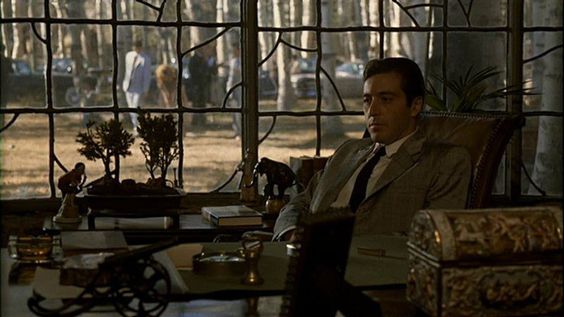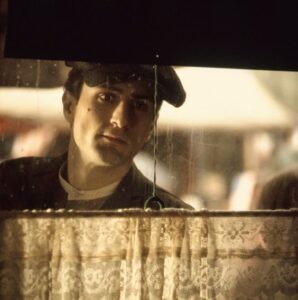
Coppola: The Godfather Part II (1974)

The Godfather Part II may well be the most ambitious film ever made about the Italian-American twentieth century. Picking up where The Godfather left off, one half of the film follows Michael Corleone in the 1960s, in the wake of the Corleone family’s relocation from New York to Lake Tahoe. The other half of the film deals with the earlier life of Vito Corleone, both as a young boy in Italy, and after his immigration to New York in the 1910s, where he is played in sepia-tinted flashbacks by Robert De Niro. While Godfather II is longer than Godfather, it’s also tighter – moving between past and present settles the episodic structure of the first film into a clearer rhythm, while there’s actually less material set in the present, despite the extended running time. In the process, Godfather II often seems to revise and query the first film as a second or third generation fantasy about the Mafia, at least in the 1960s scenes, since the historical scenes often double down on this fantasy. In fact, the fantasy of the Mafia – and the way that ceremony and spectacle has sustained that fantasy – is very much the subject matter of Godfather II, so it’s no surprise that this was easily the most ambitious and spectacular of Francis Ford Coppola’s films to date, as well as one of the high points both of his own career and of the artistic visions of New Hollywood.
Since spectacle plays such a key role, and since Godfather II effectively plays as two intertwined films, the iconic opening scene of Godfather – Connie’s wedding – is here splintered into two very different, but complementary, opening ceremonies. The very first scene is embedded more emphatically in the old country than anything we see in Godfather – and ruptured even more dramatically – as the family of nine-year old Vito are killed in Sicily in 1901, after his father insults the local Mafia boss, Don Ciccio. The film starts with the second stage in this process – the murder of Vito’s brother, Paolo – which takes place while Vito, Paolo and his mother are marching in the parade for his father’s funeral. This momentary vision of Italian community is ruptured by gunshots ringing out across the landscape, which strike Paolo, and spare Vito’s mother, only for Don Ciccio to murder her when she comes to his house to beg for mercy, before Vito just manages to get away. The visual syntax of Connie’s wedding – specifically the alternation between inky interiors and bright exteriors – is now transplanted onto this second opening scene, as Vito takes refuge during his town the following night, and then escapes, hidden, through the bright Italian landscape the next morning, making his way to the United States as soon as he possibly can
In this superb opening sequence, Coppola indicates that Godfather II will intensify the more sentimental and nostalgic elements of Godfather, but also rupture them even more dramatically – especially when they converge on ceremonial and spectacular invocations of the Italian homeland. This process continues with a complementary scene set in the late 1950s, shortly after Michael and his family have moved to Lake Tahoe – a family reunion and celebration of the Corleone family’s philanthropic work in the area. While this scene recalls many of the details of Connie’s wedding in the first film, the very fact that it is taking place in Tahoe indicates that the New York Italian-American community of Godfather has deteriorated, as has the structure of the Corleone family itself. The first person we see here is Connie, but she’s no longer the bride in Godfather II. Instead, we meet her introducing the new man in her life, and awkwardly encouraging him to call her mother “Mama,” even as her mother reproaches for having been in Tahoe for a full week without seeing her children.
